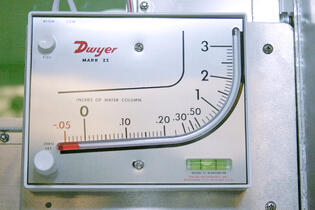This post continues our blog's examination of the exciting world of dust, why dust can be dangerous and the 'art' of containment. Again, the goal of this blog is to provide the very basics, the foundation, of infection and dust control.
 We have talked about how dust becomes infected, dust containment and the HEPA-filtration standard in relation to the prevention of hospital acquired infections. As mentioned in the last blog, however, filtration of harmful particles in the dust only happens with an appropriate air-flow in the appropriate direction.
We have talked about how dust becomes infected, dust containment and the HEPA-filtration standard in relation to the prevention of hospital acquired infections. As mentioned in the last blog, however, filtration of harmful particles in the dust only happens with an appropriate air-flow in the appropriate direction.
First off, remember that air in its natural state moves from a high pressure area to a lower pressure area (known as positve pressure). Negative air pressure alters flow of naturally moving air and prevents it from escaping to the lower pressure area. The air is seeking equilibrium.
Negative room pressure is one isolation technique employed by infection control personnel in healthcare facilities to prevent cross-contamination. It is achieved by using a fan system to generate air flow out of one isolated area where it is kept from escaping in in its natural state. The air flow is often HEPA-filtered and then exhausted into another area. The negative pressure is achieved when more air is taken out (exhausted) compared to what is allowed in (supplied).
Air pressure can best be measured with a manometer or magnahelic in water-columns in centimeters and inches. These measurements are often converted to the international measurement for pressure: the pascal (or newton per square meter). How much negative air pressure is enough? The American Institute of Architects recommends 0.01" water gauge (w.g.) or 2.5 Pacals(Pa) for all patient rooms and 0.03" w.g. or 8 Pascals(Pa) for rooms that require an advanced protected environment.
In our world this 'dirty' negative air is then pulled through a pleated pre-filter by a variable speed fan and then pushed through a HEPA-filter 99.97 (.3 microns) before being exhausted into another area. As mentioned before, we certify each unit for air-flow and air-quality. The exhaust area has also been diffused to minimize the disturbance of dust outisde of the contained area.
More on air-flow and specifically air-changers per hour in our next post. Meanwhile,if you have any questions about dust containment, HEPA-filtration, or ICRA testing of or our HEPACART™ product line, you can find out more about us at www.hepacart.com, e-mail us at info@hepacart.com or simply click the button below to download our catalog:

Also, feel free to add a comment below to further the conversation and best of luck with your next containment or filtration project.